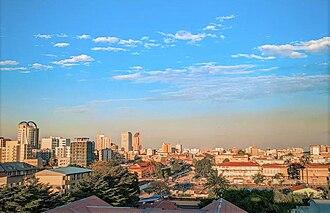October 16, 2025: Kinshasa Among Top 10 Most Polluted Cities in the World – IQAir
In a startling revelation, a new report by IQAir has identified Kinshasa, the capital of the Democratic Republic of the Congo, as one of the ten most polluted cities globally. This alarming assessment, released on October 16, 2025, highlights the escalating air quality crisis that poses significant health risks to millions of residents and exacerbates environmental concerns across the region. As urbanization and industrial activities surge, Kinshasa’s air pollution levels have reached critical heights, prompting urgent calls for action from local authorities and public health advocates alike. The findings underscore the pressing need for sustainable policies and community engagement to combat the pervasive threat of air pollution in one of Africa’s most vibrant yet vulnerable urban centers.
Kinshasa’s Pollution Crisis: An In-Depth Analysis of Contributing Factors
As Kinshasa grapples with its escalating pollution crisis, several key factors have emerged, driving the city into the ranks of the world’s most polluted urban environments. Rapid urbanization has put immense pressure on infrastructure, leading to inadequate waste management and insufficient public services. The population of Kinshasa has surged in recent years, with estimates reaching over 13 million residents. This urban sprawl has resulted in increased vehicle emissions and industrial activity, often operating without strict environmental regulations. Furthermore, a significant contributor to the city’s pollution is deforestation, which affects air quality by reducing the natural filtration system that trees provide.
Additionally, economic instability exacerbates the pollution crisis. Many residents rely on low-quality fuels for cooking and heating, resulting in high levels of indoor and outdoor air pollution. The city’s industrial sector, which is largely unregulated, discharges hazardous waste into the atmosphere and waterways. A troubling lack of public awareness further complicates the issue, with citizens often unaware of the health impacts of pollution. The authorities have acknowledged these challenges but struggle to implement effective policies, highlighting the urgent need for collaborative solutions that encompass environmental education, technological innovation, and sustainable urban planning.
The Impact of Air Quality on Public Health in Kinshasa
The latest report from IQAir has placed Kinshasa among the top 10 most polluted cities globally, highlighting a profound challenge for public health in the capital of the Democratic Republic of the Congo. The deteriorating air quality, primarily driven by increased industrial activities and vehicle emissions, poses significant health risks to the population. Experts emphasize that chronic exposure to fine particulate matter can lead to serious health conditions, such as:
- Respiratory diseases
- Cardiovascular problems
- Reduced lung function
- Increased mortality rates
Recent studies indicate that the impact of air pollution is particularly acute among vulnerable populations, including children and the elderly. Hospital admissions for respiratory issues have surged, prompting local health authorities to take urgent action. In response to this alarming trend, some measures being discussed include:
- Improved public transportation systems
- Strict regulations on industrial emissions
- Community awareness programs about air quality
| Health Impact | Estimated Cases in Kinshasa |
|---|---|
| Respiratory diseases | 150,000+ |
| Cardiovascular problems | 80,000+ |
| Children with asthma | 30,000+ |
Strategic Measures for Reducing Pollution Levels in Kinshasa’s Urban Environment
In light of recent findings that spotlight Kinshasa among the world’s most polluted cities, immediate and effective action is critical to improving the urban environment. Strategic measures must prioritize renewable energy initiatives, which can significantly reduce reliance on fossil fuels. Moreover, enhancing public transportation systems can not only alleviate traffic congestion but also decrease vehicular emissions. The integration of green spaces within urban planning is essential, facilitating better air quality and providing residents with accessible environments to engage with nature.
To support these initiatives, collaboration between government agencies, non-governmental organizations, and local communities is paramount. Implementing strict regulations on industrial emissions and promoting sustainable waste management practices will contribute to long-term improvements. Moreover, educational campaigns aimed at raising awareness about pollution and its effects can empower citizens to make environmentally conscious decisions. The following table outlines potential measures and their expected impacts:
| Measure | Expected Impact |
|---|---|
| Renewable Energy Adoption | Reduction in greenhouse gas emissions |
| Improved Public Transportation | Decreased vehicular pollution |
| Expansion of Green Spaces | Enhanced air quality and biodiversity |
| Waste Management Programs | Reduction in landfill waste and toxins |
The Conclusion
In conclusion, the alarming revelation that Kinshasa has emerged as one of the top ten most polluted cities in the world underscores a pressing environmental crisis that requires immediate attention. As documented by IQAir, the capital of the Democratic Republic of the Congo faces significant challenges related to air quality, impacting the health and well-being of its residents. This ranking serves as a clarion call for local authorities and international organizations alike to implement effective measures aimed at reducing pollution levels and fostering sustainability. As global citizens, we must remain vigilant and advocate for actions that prioritize clean air and a healthier future for all. Only through concerted efforts can we hope to alter this troubling trajectory and protect the environment for generations to come.
